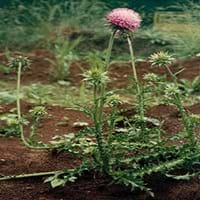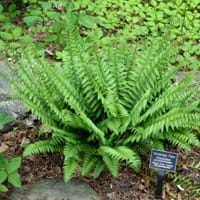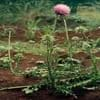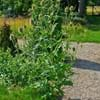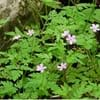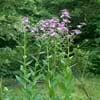Life Span
Biennial
Perennial
Type
Bulb, Flowering Plants
Fern
Origin
World/Pandemic, Europe, Asia
North America, Northeastern United States
Types
Crocus tommasinianus, Crocus etruscus, Crocus vernus, Crocus cambessedesii
Not Available
Number of Varieties
Not Available
Habitat
gardens, Grassland, open Woodlands, orchards, Pastures, tropical environments
Boggy areas, By seashore, Coastal Regions, Moist woods, Swamps
USDA Hardiness Zone
2-10
3-8
Sunset Zone
21,22
1a, 1b, 2a, 2b, 3a, 3b, 4, 5, 6, 8, 9, 14, 15, 16, 17, 18, 19, 20, 21, 22, 23, 24
Habit
Upright/Erect
Clump-Forming
Flower Color
Red, Violet
Not Available
Flower Color Modifier
Bicolor
Bicolor
Fruit Color
Not Available
Not Available
Leaf Color in Spring
Green, Dark Green
Green
Leaf Color in Summer
Dark Green
Green, Dark Green
Leaf Color in Fall
Dark Green
Green, Dark Green
Leaf Color in Winter
Light Green
Dark Green
Plant Season
Spring, Summer, Winter
Spring, Summer, Fall, Winter
Sunlight
Full Sun, Partial Sun
Full Sun, Partial shade
Growth Rate
Very Fast
Medium
Type of Soil
Clay, Loam, Sand
Loam
The pH of Soil
Acidic, Neutral, Alkaline
Acidic, Neutral
Soil Drainage
Well drained
Average
Bloom Time
Spring, Late Spring, Early Summer, Summer
Indeterminate
Tolerances
Pollution, Drought, Salt, Soil Compaction
Drought, Wet Site
Where to Plant?
Container, Ground
Container, Ground
How to Plant?
Seedlings
Divison, Spores
Plant Maintenance
Low
Medium
Watering Requirements
Average Water Needs, Do Not over Water, Never Over-water, Requires regular watering
Requires a lot of watering, Requires regular watering, Requires watering in the growing season, Water Deeply
In Summer
Lots of watering
Lots of watering
In Spring
Moderate
Moderate
In Winter
Average Water
Average Water
Soil pH
Acidic, Neutral, Alkaline
Acidic, Neutral
Soil Type
Clay, Loam, Sand
Loam
Soil Drainage Capacity
Well drained
Average
Sun Exposure
Full Sun, Partial Sun
Full Sun, Partial shade
Pruning
Prune to stimulate growth, Remove damaged leaves, Remove dead leaves, Remove deadheads
Remove damaged leaves, Remove dead branches, Remove dead leaves
Fertilizers
Nitrogen, Phosphorous, Potassium, Requires high amount of nitrogen
All-Purpose Liquid Fertilizer
Pests and Diseases
Insects, Red blotch
Red blotch
Plant Tolerance
Not Available
Drought
Flower Petal Number
Not Available
Single
Foliage Texture
Coarse
Medium
Foliage Sheen
Glossy
Matte
Attracts
Flying insects
Insects
Allergy
Diarrhea, Nausea, Vomiting
Avoid during Pregnancy, coma, Eye irritation, weakness
Aesthetic Uses
Beautification, Showy Purposes
Beautification, Landscape Designing, Showy Purposes
Beauty Benefits
Not Available
Not Available
Environmental Uses
Air purification, Food for insects
Air purification
Medicinal Uses
Unknown, Unknown
Nutrients
Part of Plant Used
Stem
Leaves
Other Uses
Decoration Purposes
Air freshner, Decoration Purposes, Employed in herbal medicine, Showy Purposes, Used for its medicinal properties
Used As Indoor Plant
No
Yes
Used As Outdoor Plant
Yes
Yes
Garden Design
Not Available
Groundcover, Mixed Border, Rock Garden, Wall
Botanical Name
CARDUUS nutans
POLYSTICHUM acrostichoides
Common Name
Musk Thistle, Nodding Thistle
Not Available
In Hindi
कस्तूरी थीस्ल
Christmas Fern
In German
Nickende Distel
Christmas Fern
In French
Musk Thistle
polystic faux-acrostic
In Spanish
Cardo de almizcle
Christmas Fern
In Greek
musk Thistle
Christmas Fern
In Portuguese
musk Thistle
Christmas Fern
In Polish
Musk Thistle
Christmas Fern
In Latin
Carduus MOSCHUS
Christmas Fern
Phylum
Magnoliophyta
Filicinophyta
Class
Magnoliopsida
Filicopsida
Order
Asterales
Filicales
Family
Asteraceae
Dryopteridaceae
Genus
Carduus
Polystichum
Clade
Angiosperms, Asterids, Eudicots
Not Available
Tribe
Cynareae
Not Available
Subfamily
Carduoideae
Not Available
Number of Species
Not Available
Not Available
Season and Care of Musk Thistle and Christmas Fern
Season and care of Musk Thistle and Christmas Fern is important to know. While considering everything about Musk Thistle and Christmas Fern Care, growing season is an essential factor. Musk Thistle season is Spring, Summer and Winter and Christmas Fern season is Spring, Summer and Winter. The type of soil for Musk Thistle is Clay, Loam, Sand and for Christmas Fern is Loam while the PH of soil for Musk Thistle is Acidic, Neutral, Alkaline and for Christmas Fern is Acidic, Neutral.
Musk Thistle and Christmas Fern Physical Information
Musk Thistle and Christmas Fern physical information is very important for comparison. Musk Thistle height is 90.00 cm and width 30.00 cm whereas Christmas Fern height is 30.50 cm and width 45.70 cm. The color specification of Musk Thistle and Christmas Fern are as follows:
Musk Thistle flower color: Red and Violet
Musk Thistle leaf color: Green and Dark Green
Christmas Fern flower color: Not Available
- Christmas Fern leaf color: Green
Care of Musk Thistle and Christmas Fern
Care of Musk Thistle and Christmas Fern include pruning, fertilizers, watering etc. Musk Thistle pruning is done Prune to stimulate growth, Remove damaged leaves, Remove dead leaves and Remove deadheads and Christmas Fern pruning is done Remove damaged leaves, Remove dead branches and Remove dead leaves. In summer Musk Thistle needs Lots of watering and in winter, it needs Average Water. Whereas, in summer Christmas Fern needs Lots of watering and in winter, it needs Average Water.
